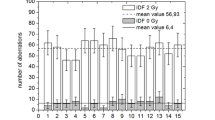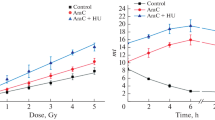Abstract
With the use of the DNA comet assay and immunocytochemical staining, regularities have been studied in the induction and repair of DNA double-strand breaks(DSBs) in human cells after exposure to 60Co γ-rays and accelerated heavy ions with different linear energy transfer (LET) in the presence of the DNA repair inhibitors cytosine arabinoside and hydroxyurea. It is shown that for heavy ions the agents’ modifying effect decreases with increasing particles’ LET. The approach involving DNA synthesis inhibitors used in this study allows an estimation of the proportion of enzymatic DNA DSBs in total DSB yield after exposure to ionizing radiations of different quality.
Similar content being viewed by others
References
R. K. Sachs, A. M. Chen, and D. J. Brenner, “Review: proximity effects in the production of chromosome aberrations by ionizing radiation,” Int. J. Radiat. Biol. 71, 1–19 (1997).
S. P. Jackson and J. Bartek, “The DNA-damage response in human biology and disease,” Nature (London, U.K.) 461 (7267), 1071–1078 (2009).
S. C. Kowalczykowski, “Initiation of genetic recombination and recombination-dependent replication,” Trends Biochem. Sci. 25, 156–165 (2000).
A. Yokoya, S. M. T. Cunniffe, R. Watanabe, K. Kobayashi, and P. O’Neill, “Induction of DNA strand breaks, base lesions and clustered damage sites in hydrated plasmid DNA films by ultrasoft X rays around the phosphorus K edge,” Radiat. Res. 172, 296–305 (2009).
A. V. Boreyko, V. N. Chausov, E. A. Krasavin, and S. I. Stukova, “The influence of DNA inhibitor synthesis on the induction and repair of double-strand DNA breaks in human lymphocytes under action of radiation with a different linear energy transfer,” Phys. Part. Nucl. Lett. 8, 399 (2011).
R. J. Fram and D. W. Kufe, “Inhibition of DNA excision repair and the repair of X-ray-induced DNA dam-age by cytosine arabinoside and hydroxyurea,” Pharmacol. Ther. 31, 165–176 (1985).
M. R. Miller and D. N. Chinault, “Evidence that DNA polymerases alpha and beta participate differentially in DNA repair synthesis induced by different agents,” J. Biol. Chem. 257, 46–49 (1982).
A. S. Prakasha Gowda, J. M. Polizzi, K. A. Eckert, and T. E. Spratt, “Incorporation of gemcitabine and cytarabine into DNA by DNA polymerase β and ligase III/XRCC1,” Biochemistry 49, 4833–4840 (2010).
A. Koç, L. J. Wheeler, C. K. Mathews, and G. F. Merrill, “Hydroxyurea arrests DNA replication by a mechanism that preserves basal DNTP pools,” J. Biol. Chem. Am. Soc. Biochem. Mol. Biol. 279, 223–230 (2004).
M. Weinfeld, A. Rasouli-Nia, M. A. Chaudhry, and R. A. Britten, “Response of base excision repair enzymes to complex DNA lesions,” Radiat. Res. 156, 584–589 (2001).
L. Harrison and S. Malyarchuk, “Can DNA repair cause enhanced cell killing following treatment with ionizing radiation?,” Pathophysiol. Off. J. Int. Soc. Pathophysiol. 8, 149–159 (2002).
B. Rydberg, “Radiation-induced heat-labile sites that convert into DNA double-strand breaks,” Radiat. Res. 153, 805–812 (2009).
H. Nikjoo, P. O’Neill, W. E. Wilson, and D. T. Goodhead, “Computational approach for determining the spectrum of DNA damage induced by ionizing radiation,” Radiat. Res. 156, 577–583 (2001).
A. Urushibara, N. Shikazono, P. O’Neill, K. Fujii, S. Wada, and A. Yokoya, “LET dependence of the yield of single-, double-strand breaks and base lesions in fully hydrated plasmid DNA films by 4 He2+ ion irradiation,” Int. J. Radiat. Biol. 84, 23–33 (2008).
V. N. Chausov, A. V. Boreyko, E. A. Krasavin, A. V. Mozhaeva, I. I. Ravnachka, S. I. Tiounchik, and V. A. Tronov, “Regularities of induction and repair of double-stranded DNA ruptures in human lymphocytes under the action of accelerated heavy ions of different energies,” Rad. Biol. Radioekol. 49, 73–77 (2009).
M. G. Zadneprianetc, A. V. Boreyko, T. S. Bulanova, L. Ježková, E. A. Krasavin, E. A. Kulikova, E. V. Smirnova, M. Fal’k, and I. Fal’kova, “Regularities in the formation and elimination of γH2AX/53BP1 foci after γ-ray and accelerated heavy ion irradiation,” Rad. Biol. Radioekol. 58, 146–156 (2018).
A. A. Bezbakh, V. B. Zager, G. Kaminski, A. I. Krylov, V. A. Krylov, Yu. G. Teterev, and G. N. Timoshenko, “Upgrading the Genome facility for radiobiological experiments with heavy-ion beams,” Phys. Part. Nucl. Lett. 10, 175 (2013).
K. Końca, A. Lankoff, A. Banasik, H. Lisowska, T. Kuszewski, S. Góźdź, Z. Koza, and A. Wojcik, “A cross-platform public domain PC image-analysis program for the comet assay,” Mutat. Res. 534, 15–20 (2003).
V. A. Tronov and I. I. Pelevina, “The method of DNAcomets of individual cells. Principle and application of the method,” Tsitologiya 38, 427–439 (1996).
M. Kozubek, P. Matula, P. Matula, and S. Kozubek, “Automated acquisition and processing of multidimensional image data in confocal in vivo microscopy,” Microsc. Res. Techol. 64, 164–175 (2004).
T. M. Coquerelle, K. F. Weibezahn, and C. Lucke-Huhle, “Rejoining of double strand breaks in normal human and ataxia-telangiectasia fibroblasts after exposure to 60Co gamma-rays, 241Am alpha-particles or bleomycin,” Int. J. Radiat. Biol. Relat. Stud. Phys. Chem. Med. 51, 209–218 (1987).
R. Okayasu, “Repair of DNA damage induced by accelerated heavy ions-a mini review,” Int. J. Cancer 130, 991–1000 (2012).
M. Wang, J. Saha, M. Hada, J. A. Anderson, J. M. Pluth, P. O’Neill, and F. A. Cucinotta, “Novel smad proteins localize to IR-induced double-strand breaks: interplay between TGFβ and ATM pathways,” Nucl. Acid Res. 41, 933–942 (2013).
P. Calsou and B. Salles, “Properties of damage-dependent DNA incision by nucleotide excision repair in human cell-free extracts,” Nucl. Acids Res. 22, 4937–4942 (1994).
V. Michalik, “Model of DNA damage induced by radiations of various qualities,” Int. J. Radiat. Biol. 62, 9–20 (1992).
R. Hirayama, A. Ito, M. Tomita, T. Tsukada, F.Yatagai, M. Noguchi, Y. Matsumoto, Y. Kase, K. Ando, R. Okayasu, and Y. Furusawa, “Contributions of direct and indirect actions in cell killing by high-LET radiations,” Radiat. Res. 171, 212–218 (2009).
K. Rothkamm and M. Lobrich, “Evidence for a lack of DNA double-strand break repair in human cells exposed to very low X-ray doses,” Proc. Natl. Acad. Sci. U.S.A. 100, 5057–5062 (2003).
C. E. Redon, J. S. Dickey, W. M. Bonner, and O. A. Sedelnikova, “γ-H2AX as a biomarker of DNA damage induced by ionizing radiation in human peripheral blood lymphocytes and artificial skin,” Adv. Space Res. 43, 1171–1178 (2009).
Author information
Authors and Affiliations
Corresponding author
Additional information
Original Russian Text © V.N. Chausov, A.V. Boreyko, T.S. Bulanova, M.G. Zadneprianetc, E.V. Ilyina, L. Ježková, E.A. Krasavin, R.A. Kozhina, E.A. Kuzmina, E.A. Kulikova, E.V. Smirnova, S.I. Tiounchik, 2018, published in Pis’ma v Zhurnal Fizika Elementarnykh Chastits i Atomnogo Yadra, 2018.
Rights and permissions
About this article
Cite this article
Chausov, V.N., Boreyko, A.V., Bulanova, T.S. et al. Formation of Direct and Enzymatic DNA Double-Strand Breaks in the Presence of Repair Inhibitors after Exposure to Radiations of Different Quality. Phys. Part. Nuclei Lett. 15, 700–710 (2018). https://doi.org/10.1134/S1547477118060055
Received:
Published:
Issue Date:
DOI: https://doi.org/10.1134/S1547477118060055




